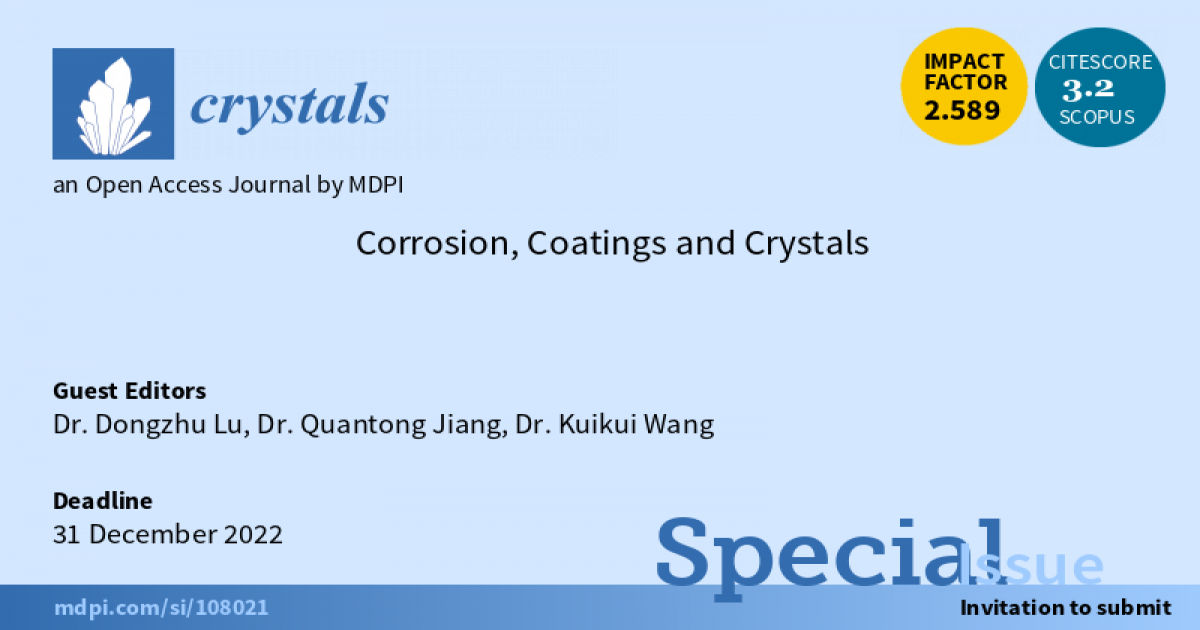Corrosion, Coatings and Crystals
A special issue of Crystals (ISSN 2073-4352). This special issue belongs to the section "Crystalline Metals and Alloys".
Deadline for manuscript submissions: closed (31 December 2022) | Viewed by 14432

Special Issue Editors
Interests: coating; surface diffusion; magnesium; powder
Interests: magnesium alloy; corrosion; marine
Special Issue Information
Dear Colleagues,
Corrosion is a naturally occurring phenomenon with a costly and detrimental impact on many critical industries. The national costs of corrosion generally represent approximately 1–5% of the GNP. Hence, it is important to understand the corrosion mechanisms and try to protect structures from severe corrosion.
Corrosion phenomena are closely related to the crystalline structures of matrixes. For example, the corrosion rate of different grains varies with the symmetry of the exposed crystalline face. Meanwhile, the grain boundary could also be vulnerable to corrosive ions due to the irregular distribution of atoms. Thus, it is critical to understand the corrosion process of materials by analysing the crystalline structures on the surfaces of materials.
After corrosion, the substrates are usually covered with corrosion products. The properties of these products have a great impact on the following corrosion process of the matrix. A dense, stable, and crack-free corrosion product layer could protect the matrix from a corrosive environment, while loose and unstable corrosion products many promote the corrosion process. Hence, it is important to study the relationship between corrosion behaviours and the crystalline corrosion products.
To inhibit the corrosion of a substrate, one of the most effective methods is to cover the substrate with a coating. A protective coating should combine with the matrix tightly and be compact and stable under certain corrosive environments. Many protective coatings have crystalline structures. The size and arrangement of grains and phases in the coating could also affect the corrosion resistance of the coating.
This Special Issue, “Corrosion, Coatings and Crystals”, aims to publish novel findings which focus on the effect of the crystalline structure of the matrix and coatings on the properties of the substrate, especially the corrosion behaviour of the substrate. Meanwhile, studies related to the degradation or enhancement of the surface of crystalline structures are also preferred.
It is our pleasure to invite you to submit full papers, communications, and reviews related to “Corrosion, Coatings and Crystals”.
Dr. Dongzhu Lu
Dr. Quantong Jiang
Dr. Kuikui Wang
Guest Editors
Manuscript Submission Information
Manuscripts should be submitted online at www.mdpi.com by registering and logging in to this website. Once you are registered, click here to go to the submission form. Manuscripts can be submitted until the deadline. All submissions that pass pre-check are peer-reviewed. Accepted papers will be published continuously in the journal (as soon as accepted) and will be listed together on the special issue website. Research articles, review articles as well as short communications are invited. For planned papers, a title and short abstract (about 250 words) can be sent to the Editorial Office for assessment.
Submitted manuscripts should not have been published previously, nor be under consideration for publication elsewhere (except conference proceedings papers). All manuscripts are thoroughly refereed through a single-blind peer-review process. A guide for authors and other relevant information for submission of manuscripts is available on the Instructions for Authors page. Crystals is an international peer-reviewed open access monthly journal published by MDPI.
Please visit the Instructions for Authors page before submitting a manuscript. The Article Processing Charge (APC) for publication in this open access journal is 2100 CHF (Swiss Francs). Submitted papers should be well formatted and use good English. Authors may use MDPI's English editing service prior to publication or during author revisions.
Keywords
- corrosion
- coatings
- grain
- surface
- crystalline
Benefits of Publishing in a Special Issue
- Ease of navigation: Grouping papers by topic helps scholars navigate broad scope journals more efficiently.
- Greater discoverability: Special Issues support the reach and impact of scientific research. Articles in Special Issues are more discoverable and cited more frequently.
- Expansion of research network: Special Issues facilitate connections among authors, fostering scientific collaborations.
- External promotion: Articles in Special Issues are often promoted through the journal's social media, increasing their visibility.
- Reprint: MDPI Books provides the opportunity to republish successful Special Issues in book format, both online and in print.
Further information on MDPI's Special Issue policies can be found here.






